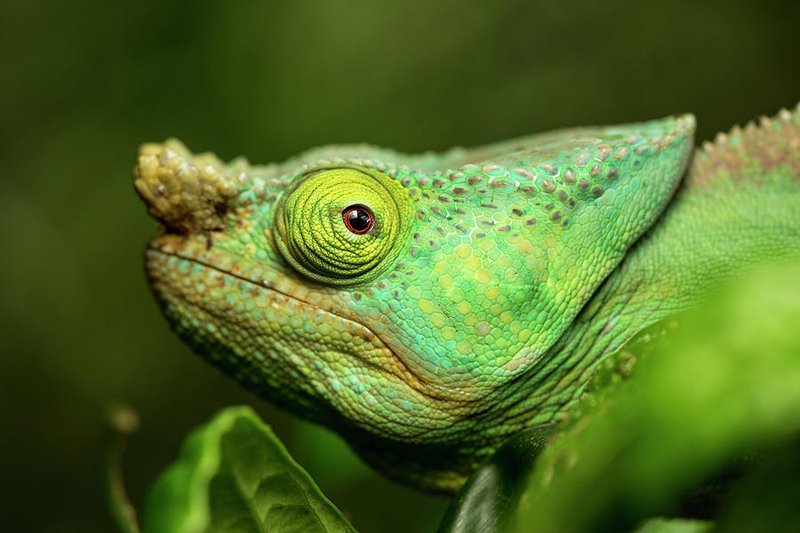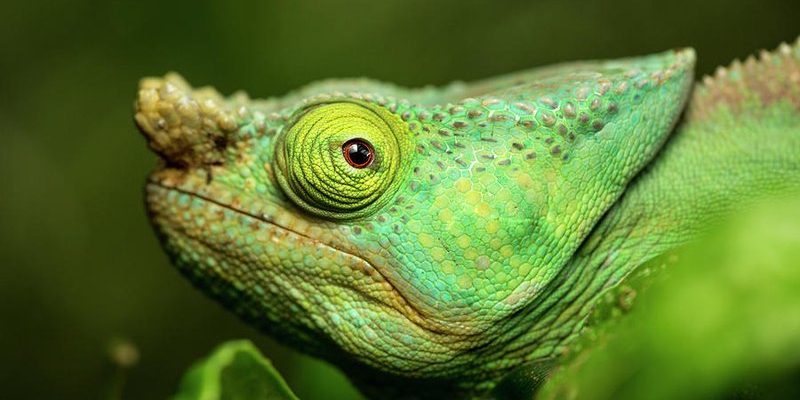
To kick things off, a Parson’s chameleon (scientifically known as *Calumma parsonii*) hails from the lush rainforests of Madagascar. If you’re lucky enough to see one in person, you’re in for a treat! With their large size, vibrant coloration, and distinctive physical traits, these chameleons are relatively easy to spot when you know what to look for. So, grab your curiosity, and let’s dive into the world of Parson’s chameleons!
Physical Characteristics of Parson’s Chameleons
If you’re trying to identify a Parson’s chameleon, one of the first things to consider is its physical appearance. These chameleons are known for being the largest species in the family, reaching lengths of up to 27 inches! That’s not a tiny lizard by any means.
Their bodies are robust and somewhat flattened, giving them a unique silhouette. The skin color can range from vivid greens and blues to striking yellows and oranges. Honestly, it’s like nature’s art palette right in front of you! When you see one basking in the sun, you might even notice how the colors shift slightly based on its mood or environment, showcasing that classic chameleon charm.
In terms of physical features, look for the large crest on their head. This crest is more pronounced in males, making them even easier to spot. You might also notice their big, bulging eyes that can move independently. Can you imagine having eyes that can look in two different directions at once? That’s a big advantage when you’re out there trying to avoid predators!
Behavioral Traits
Now that you’re getting a sense of what they look like, let’s discuss their behavior. Parson’s chameleons are known to be quite territorial, especially the males. They often display their colors more vibrantly when they feel threatened or are trying to impress a female. It’s like a colorful version of raising your flag to say, “Hey, this is my turf!”
You might be wondering how they use their color-changing abilities. While they can blend in with their surroundings, they also change colors to express emotions or communicate with others. For instance, a bright, vibrant color might signal excitement, while darker shades can indicate stress or aggression. If you ever catch one in a display of colors, consider yourself lucky—it’s a beautiful show of nature at play.
Another interesting trait is their unique way of moving. Parson’s chameleons usually take their time when moving from branch to branch. They do this by slowly shifting their bodies while gripping onto branches with their zygodactylous feet. It’s like watching a slow-motion dance!
Habitat and Range
Understanding where Parson’s chameleons live can help you identify them in the wild. These reptiles are typically found in the rainforests of Madagascar, preferring lush environments filled with trees and plants. Their ideal habitat has plenty of branches and foliage, which allows them to hunt their favorite food—mainly insects. Just think about how cozy and safe you’d feel in a thick, green forest surrounded by leaves!
In Madagascar, you can find them at various altitudes, from coastal areas to highland forests. This adaptability means they’ve carved out a niche for themselves in many different parts of the island. If you’re on a mission to find one, consider looking in protected areas or national parks where they thrive.
Although they’re found primarily in Madagascar, they are sometimes kept as pets, which means you might come across them in exotic pet stores. However, if you do see one outside its natural habitat, it’s essential to know it’s a wild animal that deserves respect and protection.
Diet and Feeding Habits
If you’re hoping to spot a Parson’s chameleon, it helps to know what they eat. Honestly, these little (or big!) guys are insectivores. They primarily feast on a diet of various insects, such as crickets, beetles, and grasshoppers. It’s pretty fascinating how they can catch their prey with that long, sticky tongue—like a slingshot ready to strike!
You might be curious about their feeding habits. Parson’s chameleons are typically daytime hunters. They sit patiently and wait for their food to come close before using their quick reflexes to catch their meal. It’s almost like playing a game of hide and seek, where they’ve mastered the art of being both the hunter and the hider.
If you ever find yourself in Madagascar, you might want to keep an eye on where insects are buzzing about; that’s likely where you’ll spot a chameleon doing its thing. Just remember, they play an important role in their ecosystem by controlling insect populations.
Conservation Status
Here’s the thing: while Parson’s chameleons are captivating, they face threats in their natural habitat. Deforestation, habitat loss, and the illegal pet trade have put a strain on their populations. According to the International Union for Conservation of Nature (IUCN), these chameleons are listed as vulnerable.
Why should we care? Well, chameleons, including the Parson’s species, play a crucial role in maintaining the balance of their ecosystems. They help control insect populations and serve as prey for other animals. Losing them would disrupt the delicate web of life in their habitats.
If you’re passionate about wildlife conservation, there are steps you can take. Supporting organizations that work to protect Madagascar’s rainforests and wildlife can make a real difference. Spreading awareness about the impact of illegal wildlife trade is also essential. Every small action counts!
Captive Care and Keeping Parson’s Chameleons
If you’ve ever considered owning a Parson’s chameleon, it’s important to understand their specific needs. While they can be kept as pets, they require specialized care to thrive. Here’s what to keep in mind:
First off, they need a spacious enclosure with plenty of foliage for climbing. Think of it like creating a miniature rainforest. It’s important to provide UVB lighting to help them synthesize Vitamin D3, which is crucial for their health. This isn’t just a casual detail—it’s vital for their well-being!
Feeding them is another crucial aspect. A varied diet of live insects is a must, and you’ll also need to dust the food with calcium and vitamin supplements regularly. Just imagine being their chef, whipping up a nutritious meal that keeps them healthy and happy.
Finally, consider the temperature and humidity levels. Parson’s chameleons thrive in humid environments, so misting their habitat daily will keep them comfortable. Plus, maintaining a temperature gradient allows them to regulate their body heat effectively. Caring for a chameleon can be a rewarding experience, but it’s a commitment that requires research and preparation.
In Conclusion
So there you have it! Identifying a Parson’s chameleon is about understanding its vibrant colors, fascinating behaviors, and unique habitat. From their impressive physical traits to their complex needs in captivity, these chameleons are truly remarkable creatures. Whether you see one in the wild or consider keeping one as a pet, knowing their characteristics and care requirements can enhance your appreciation.
Remember, it’s not just about spotting a chameleon—it’s about respecting its role in nature and working towards a future where these beautiful reptiles can thrive. So next time you think of chameleons, think of the Parson’s—they’re more than just pretty colors; they’re a vital part of our planet’s ecosystem. Enjoy the journey of spotting and learning about these incredible creatures!

